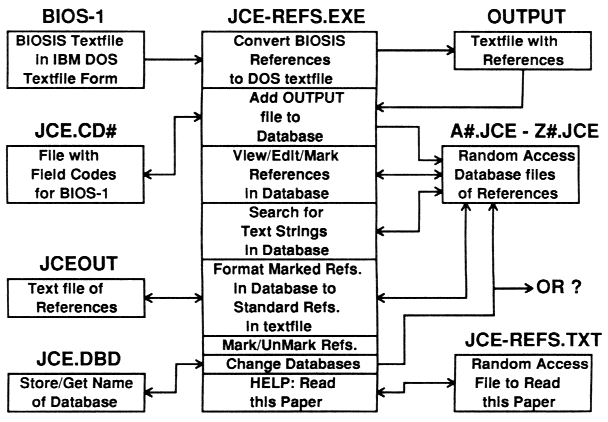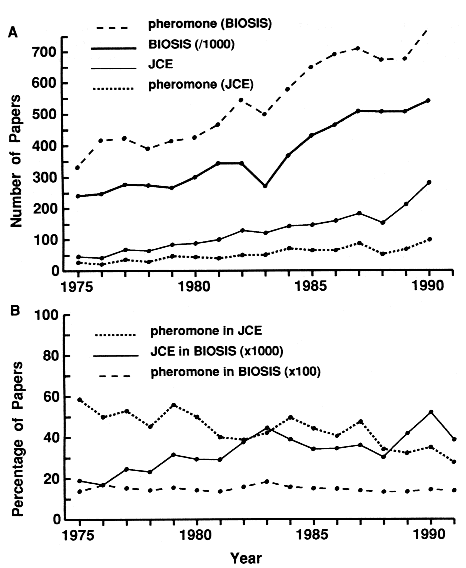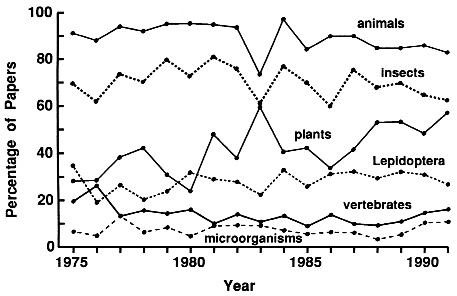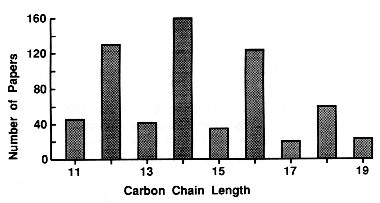(A)
AN 85088636 8800.
AU BYERS-J-A.
TI NOVEL DIFFUSION-DILUTION METHOD FOR RELEASE OF SEMIOCHEMICALS TESTING
PHEROMONE COMPONENT RATIOS ON WESTERN PINE BEETLE.
SO J-CHEM-ECOL 14 (1). 1988. 199-212.
IN DEP ANIMAL ECOL, UNIV LUND, S-223 62 LUND, SWED.
LG EN.
YR 88.
KW DENDROCTONUS-BREVICOMIS TEMNOCHILA-CHLORODIA PREDATOR MYRCENE
EXOBREVICOMIN PESTS.
BC 75304 Coleoptera.
ST ANIMALS#, INVERTEBRATES#, ARTHROPODS#, INSECTS#.
AB Each of the pheromone components of the Western pine beetle,
Dendroctonus brevicomis LeC. (Coleoptera: Scolytidae), exo-brevicomin
(E) and frontalin (F), were released in the forest at various ratios
etc...
(B)
Byers, J.A. 1988. novel diffusion-dilution method for release of
semiochemicals testing pheromone component ratios on western pine beetle. J.
Chem. Ecol. 14 (1). 199-212.==dendroctonus-brevicomis temnochila-chlorodia
predator myrcene exobrevicomin pests. 75304 coleoptera. animals#.
invertebrates#, arthropods#, insects#. ab each of the pheromone components of
the western pine beetle, dendroctonus brevicomis lec. (coleoptera: scolytidae),
exo-brevicomin (e) and frontalin (f), were released in the forest at various
ratios etc...
dep animal ecol, univ lund, s-223 62 lund, swed
(C)
Byers, J.A. 1988. novel diffusion-dilution method for release of semiochemicals
testing pheromone component ratios on western pine beetle. J. Chem. Ecol. 14 (1)
. 199-212.==dendroctonus-brevicomis temnochila-chlorodia predator myrcene exobre
vicomin pests. 75304 coleoptera. animals#, invertebrates#, arthropods#, insects#
. ab each of the pheromone components of the western pine beetle, dendroctonus b
revicomis lec. (coleoptera: scolytidae), exo-brevicomin (e) and frontalin (f), w
ere released in the forest at various ratios etc...
dep animal ecol, univ lund, s-223 62 lund, swed
FIG. 2. The JCE-REFS.EXE program processes a BIOSIS text file (A) into a DOS text
file (OUTPUT) as shown in (B), which is imported into the random access database file
(B#.JCE) as in (C) that can be searched. The reference in the data base also can be
exported as a DOS text file (B) or Pro-Cite style (not shown) for use with MacIntosh
and IBM-compatible personal computers.
The user may look at the BIOS-1 file to see if the
formatting is such that all text is indented three spaces except for the field codes.
Rarely, the file can be received from BIOSIS in a corrupted condition; in this
case a reformatting facility is selected to correct the file. Otherwise the user
continues and is presented with a list of files (ending in .CD#) that contain
various field codes appropriate to the commercial data base. The user enters one
of the names or a new name, and the field codes are loaded and presented on a
menu for editing. The field codes can be used without editing or new codes
added for the respective authors, title, journal, and so forth. These codes make
it possible to accommodate any of several types of BIOSIS formats as well as
other data base styles such as CA Search and MEDLINE. The program then
reformats the BIOSIS file (BIOS-1) using the field codes. The first letters of
authors are capitalized and appropriate punctuation is added. The date (1900s
or 2000s) is extracted from the journal string. The title and journal letters are
uncapitalized and then the first letter of each word in the journal is capitalized.
This saves time in the word processor as most letters need to be lowercase in a
standard citation. The abstract text is also uncapitalized so that all text searches
can be in lowercase. The resulting sequential file, OUTPUT (Figure 2B), is
overwritten each time, so one must process the contents, as described subsequently,
before another BIOSIS file is reformatted.
After reformatting the BIOSIS file, the second option is used in which the
OUTPUT file is entered as the source of references for alphabetical placement
in the 26 data base files (e.g., A#.JCE to Z#.JCE). Each reference is formed
into a long text string of 36 lines by 80 characters, so the abstract can be included
(Figure 2C). These 26 files are random access in which references from additional
BIOSIS Previews files can be added by running options one and two
again. Alternatively, another name can be chosen (option seven) in order to
create additional data bases (e.g., for another journal).
The third option "View/Edit/Mark References in Data Base" allows one
to scroll through the data base and view the references. Any references that are
desired for word processing can be exported as a citation in the file JCEOUT
by marking them (pressing the Insert key). References are unmarked with the
Delete key. A global unmarking of all references also can be done (in option
six). Facilities for searching for a text string and viewing the located reference
and highlighted string are provided while viewing the data base.
The fourth option, "Search for Text Strings in Data Base," allows complex
logic searches of the data base fields for up to two sets of 20 text strings
simultaneously. The searches employ Boolean logic in one of four ways. Up to
20 text strings can be searched for in either an: (1) OR or (2) AND way. These
also can be combined into: (3) AND/OR or (4) AND+OR searches with a total
of up to 40 text strings. For example, an AND+OR search might look for
("pheromone" AND "Scolytidae") and (" 1980. " OR " 1981. " OR " 1982. ")
in each reference. Note the use of the space and period in the dates in order to
avoid finding page numbers.
Prior to searching for the text strings, the user is asked whether he or she
wants to save this search profile for later recall. If the search profile is saved,
then the next time a search is made the user may select option five to load the
search profile and begin the search without the need for entering the text strings.
During the search of the data base, the program displays any located references
on screen and waits for keyboard input to mark (or unmark) or continue without
marking until all references in the data base are searched. Options include
searches of various combinations of authors, date, title, key words, abstract,
and address. A search record showing the number of references found out of
the total number in the data base is displayed at the end of the search (searches
take only some seconds for 2133 references).
The fifth option, "Format Marked Refs. in Data Base to Standard Refs. in
Text File," is used to take the author, date, title, journal, and, optionally, the
key words, abstract (if present), and address strings and export them. These are
saved in a DOS text file called JCEOUT (style as in Figure 2B), which is
overwritten each time this option is chosen. This file can then be imported into
any word-processing program (e.g., WordPerfect, WordPerfect Corp., Orem,
Utah) as well as into the scientific reference manager, CardCat (Byers, 1991).
A sixth option includes either a global unmarking or global marking of a11
references in the data base. The "Change Data Bases" option allows for an
almost unlimited number of databases, 208 available ASCII characters for file
names = [[SUM for i=1 to 8] Pi208][[SUM for i=1 to 3] Pi208] = 2.7 x 1025.
Each time the program is
started, it gets the current data base, which is permanently stored in the file
JCE.DBD until changed by the user. The user can receive help from within the
program by reading the file JCE-REFS.TXT, which includes the contents of
this paper with figures. This file appears to be a standard sequential DOS text
file but is actually a random access file that allows scrolling the text forward
and backward on the screen.
BIOSIS Previews (from Data-Star, Radio-Suisse) was searched for all articles
published in the Journal of Chemical Ecology (including abstracts and
addresses) from 1975 until October 1991. The resulting search file was downloaded
into 16 files of about 200K each to a personal computer. The files were
imported into the JCE-REFS program, which made a data base of 26 files with
a total of 6 megabytes. This data base was searched by year, as described below,
for certain key words as shown in Figures 3-5 and Tables 1-5 below. Except
for the super taxonomic designations of BIOSIS (ending in #, as in Table 2 and
Figure 4), it should be noted that the incidence of various key words found in
the titles, key words, and abstracts are minimal estimates since the entire article
was not searched. Furthermore, certain key words are more likely to be mentioned
in the abstract than others due to the nature of the words. However, key
words merely mentioned in the body of the paper, and not in the title, key
words, or abstract, quite often are not of primary relevance to the article.





